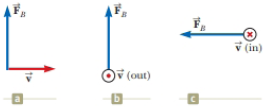
Webassign Printed Access Card For Serway/jewett's Physics For Scientists And Engineers, 10th, Single-term
10th Edition
ISBN: 9781337699266
Author: Raymond A. Serway, John W. Jewett
Publisher: Cengage Learning
expand_more
expand_more
format_list_bulleted
Concept explainers
Textbook Question
Chapter 28, Problem 3P
Find the direction of the magnetic field acting on a positively charged particle moving in the various situations shown in Figure P28.3 if the direction of the magnetic force acting on it is as indicated.
Figure P28.3

Expert Solution & Answer
Trending nowThis is a popular solution!

Students have asked these similar questions
No chatgpt pls will upvote
No chatgpt pls will upvote
A rod 12.0 cm long is uniformly charged and has a total charge of -20.0 μc. Determine the magnitude and direction of the electric field along the axis of the rod at a point
32.0 cm from its center.
361000
☑
magnitude
What is the general expression for the electric field along the axis of a uniform rod? N/C
direction toward the rod
Chapter 28 Solutions
Webassign Printed Access Card For Serway/jewett's Physics For Scientists And Engineers, 10th, Single-term
Ch. 28.1 - An electron moves in the plane of this paper...Ch. 28.2 - Prob. 28.2QQCh. 28.4 - A wire carries current in the plane of this paper...Ch. 28.5 - (i) Rank the magnitudes of the torques acting on...Ch. 28 - At the equator, near the surface of the Earth, the...Ch. 28 - Consider an electron near the Earths equator. In...Ch. 28 - Find the direction of the magnetic field acting on...Ch. 28 - A proton moving at 4.00 106 m/s through a...Ch. 28 - A proton travels with a speed of 5.02 106 m/s in...Ch. 28 - A laboratory electromagnet produces a magnetic...
Ch. 28 - A proton moves perpendicular to a uniform magnetic...Ch. 28 - An accelerating voltage of 2.50103 V is applied to...Ch. 28 - A proton (charge + e, mass mp), a deuteron (charge...Ch. 28 - Review. A 30.0-g metal hall having net charge Q =...Ch. 28 - Review. One electron collides elastically with a...Ch. 28 - Review. One electron collides elastically with a...Ch. 28 - Review. An electron moves in a circular path...Ch. 28 - A cyclotron designed to accelerate protons has a...Ch. 28 - Prob. 15PCh. 28 - Singly charged uranium-238 ions are accelerated...Ch. 28 - A cyclotron (Fig. 28.16) designed to accelerate...Ch. 28 - A particle in the cyclotron shown in Figure 28.16a...Ch. 28 - Prob. 19PCh. 28 - A straight wire earning a 3.00-A current is placed...Ch. 28 - A wire carries a steady current of 2.40 A. A...Ch. 28 - Why is the following situation impossible? Imagine...Ch. 28 - Review. A rod of mass 0.720 kg and radius 6.00 cm...Ch. 28 - Review. A rod of mass m and radius R rests on two...Ch. 28 - A wire having a mass per unit length of 0.500 g/cm...Ch. 28 - Consider the system pictured in Figure P28.26. A...Ch. 28 - A strong magnet is placed under a horizontal...Ch. 28 - In Figure P28.28, the cube is 40.0 cm on each...Ch. 28 - A magnetized sewing needle has a magnetic moment...Ch. 28 - A 50.0-turn circular coil of radius 5.00 cm can be...Ch. 28 - You are in charge of planning a physics magic show...Ch. 28 - You are working in your dream job: an assistant...Ch. 28 - A rectangular coil consists of N = 100 closely...Ch. 28 - A rectangular loop of wire has dimensions 0.500 m...Ch. 28 - A wire is formed into a circle having a diameter...Ch. 28 - A Hall-effect probe operates with a 120-mA...Ch. 28 - Prob. 37APCh. 28 - Figure 28.11 shows a charged particle traveling in...Ch. 28 - Within a cylindrical region of space of radius 100...Ch. 28 - Prob. 40APCh. 28 - Prob. 41APCh. 28 - (a) A proton moving with velocity v=ii experiences...Ch. 28 - A proton having an initial velocity of 20.0iMm/s...Ch. 28 - You have been called in as an expert witness in a...Ch. 28 - Prob. 45APCh. 28 - Why is the following situation impossible? Figure...Ch. 28 - A heart surgeon monitors the flow rate of blood...Ch. 28 - Review. (a) Show that a magnetic dipole in a...Ch. 28 - Consider an electron orbiting a proton and...Ch. 28 - Protons having a kinetic energy of 5.00 MeV (1 eV...Ch. 28 - Review. A wire having a linear mass density of...
Knowledge Booster
Learn more about
Need a deep-dive on the concept behind this application? Look no further. Learn more about this topic, physics and related others by exploring similar questions and additional content below.Similar questions
- A certain brand of freezer is advertised to use 730 kW h of energy per year. Part A Assuming the freezer operates for 5 hours each day, how much power does it require while operating? Express your answer in watts. ΜΕ ΑΣΦ ? P Submit Request Answer Part B W If the freezer keeps its interior at a temperature of -6.0° C in a 20.0° C room, what is its theoretical maximum performance coefficient? Enter your answer numerically. K = ΜΕ ΑΣΦ Submit Request Answer Part C What is the theoretical maximum amount of ice this freezer could make in an hour, starting with water at 20.0°C? Express your answer in kilograms. m = Ο ΑΣΦ kgarrow_forwardDescribe the development of rational choice theory in sociology. Please includearrow_forwardA-E pleasearrow_forward
- A 11.8 L gas tank containing 3.90 moles of ideal He gas at 26.0°C is placed inside a completely evacuated insulated bell jar of volume 39.0 L .A small hole in the tank allows the He to leak out into the jar until the gas reaches a final equilibrium state with no more leakage. Part A What is the change in entropy of this system due to the leaking of the gas? ■ ΜΕ ΑΣΦ AS = ? J/K Submit Request Answer Part B Is the process reversible or irreversible?arrow_forwardA-E pleasearrow_forwardThree moles of an ideal gas undergo a reversible isothermal compression at 20.0° C. During this compression, 1900 J of work is done on the gas. For related problem-solving tips and strategies, you may want to view a Video Tutor Solution of Entropy change in a free expansion. Part A What is the change of entropy of the gas? ΤΕ ΑΣΦ AS = Submit Request Answer J/Karrow_forward
- 5.97 Block A, with weight 3w, slides down an inclined plane S of slope angle 36.9° at a constant speed while plank B, with weight w, rests on top of A. The plank is attached by a cord to the wall (Fig. P5.97). (a) Draw a diagram of all the forces acting on block A. (b) If the coefficient of kinetic friction is the same between A and B and between S and A, determine its value. Figure P5.97 B A S 36.9°arrow_forwardPlease take your time and solve each part correctly please. Thank you!!arrow_forwardhelp me answer this with explanations! thanks so mucharrow_forward
- No chatgpt pls will upvote Alreadyarrow_forwardWhat fuel economy should be expected from a gasoline powered car that encounters a total of 443N of resistive forces while driving down the road? (Those forces are from air drag, rolling resistance and bearing losses.) Assume a 30% thermodynamic efficiency.arrow_forwardNo chatgpt pls will upvotearrow_forward
arrow_back_ios
SEE MORE QUESTIONS
arrow_forward_ios
Recommended textbooks for you
 Glencoe Physics: Principles and Problems, Student...PhysicsISBN:9780078807213Author:Paul W. ZitzewitzPublisher:Glencoe/McGraw-Hill
Glencoe Physics: Principles and Problems, Student...PhysicsISBN:9780078807213Author:Paul W. ZitzewitzPublisher:Glencoe/McGraw-Hill Principles of Physics: A Calculus-Based TextPhysicsISBN:9781133104261Author:Raymond A. Serway, John W. JewettPublisher:Cengage Learning
Principles of Physics: A Calculus-Based TextPhysicsISBN:9781133104261Author:Raymond A. Serway, John W. JewettPublisher:Cengage Learning College PhysicsPhysicsISBN:9781938168000Author:Paul Peter Urone, Roger HinrichsPublisher:OpenStax College
College PhysicsPhysicsISBN:9781938168000Author:Paul Peter Urone, Roger HinrichsPublisher:OpenStax College Physics for Scientists and EngineersPhysicsISBN:9781337553278Author:Raymond A. Serway, John W. JewettPublisher:Cengage Learning
Physics for Scientists and EngineersPhysicsISBN:9781337553278Author:Raymond A. Serway, John W. JewettPublisher:Cengage Learning Physics for Scientists and Engineers with Modern ...PhysicsISBN:9781337553292Author:Raymond A. Serway, John W. JewettPublisher:Cengage Learning
Physics for Scientists and Engineers with Modern ...PhysicsISBN:9781337553292Author:Raymond A. Serway, John W. JewettPublisher:Cengage Learning

Glencoe Physics: Principles and Problems, Student...
Physics
ISBN:9780078807213
Author:Paul W. Zitzewitz
Publisher:Glencoe/McGraw-Hill

Principles of Physics: A Calculus-Based Text
Physics
ISBN:9781133104261
Author:Raymond A. Serway, John W. Jewett
Publisher:Cengage Learning

College Physics
Physics
ISBN:9781938168000
Author:Paul Peter Urone, Roger Hinrichs
Publisher:OpenStax College

Physics for Scientists and Engineers
Physics
ISBN:9781337553278
Author:Raymond A. Serway, John W. Jewett
Publisher:Cengage Learning

Physics for Scientists and Engineers with Modern ...
Physics
ISBN:9781337553292
Author:Raymond A. Serway, John W. Jewett
Publisher:Cengage Learning

Magnets and Magnetic Fields; Author: Professor Dave explains;https://www.youtube.com/watch?v=IgtIdttfGVw;License: Standard YouTube License, CC-BY